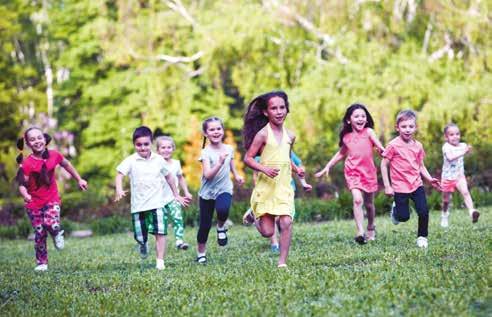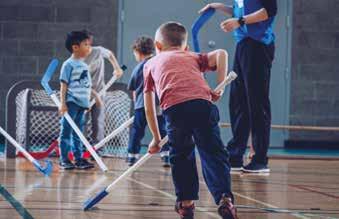
9 minute read
The importance of science in the early years
By Natacha V. Beim, Founder of CEFA Early Learning Schools and Parenting with Natacha
Children are natural born scientists. To nurture this type of learning in children, allow them to explore their environment safely, freely, and with plenty of time. Children have this fascinating sense of wonder and curiosity about the world. They build theories, test them, evaluate what worked and what didn’t, then figure out why. They try to figure out why water and dirt combine to make mud, why some things float in the tub while others sink to the bottom. They try to understand how shadows work or why caterpillars make cocoons.
Advertisement
Encouraging children to explore their natural curiosity is one of the best ways for them to learn science. It helps them think in an increasingly complex way. Science also allows children to see themselves as contributing individuals, as they are trusted to solve problems.
The many benefits of exposing your child to science include: • Advancement of critical and creative thinking as well as problem-solving • Increased vocabulary, math, and physics skills • Perseverance and an understanding that failure helps them learn • Patience as they observe nature around them, and discover some changes take time • Worldliness as they take an interest in the world around them to discover how things work • Critical thinking and the ability to form their own opinions and draw conclusions from observations l Are children ready to learn science?
Almost all young children are already learning science naturally, without any prompting. Most of the time they actively search for new knowledge and experiences in the world around them. They develop theories about what they see and how it works.
As many parents of young children will attest, their child’s favorite question for years is, “Why?” Their favorite activity is taking things apart, and they can spend hours in the park or garden, observing how the ants transport the crumbs of their muffin into a tiny hole in the ground.
Children are eager to figure out why turning the light on makes everything so bright or what happens if they plug something into the electrical socket. In an effort to keep them safe (and to keep the house a little cleaner), we often stop our kids from discovering the world around them. Slowly, over the years, many children sadly lose that inquisitive spark they were born with. As a result, creative thinking is compromised. However, it is those same creative-thinking skills that will help them succeed in the future by contributing new ideas or challenging the status quo.
l Here’s how it works
From the time they are born, children form concepts about what they see. As they grow, these concepts evolve and become more complex, as does their ability to make deductions and to problem-solve. As they do that, their knowledge expands, and they become more adept at observing. Children formulate their own hypotheses and test those in an increasingly complex way. They then organize and classify the newly-acquired knowledge, generalize across disciplines, relate it to their own life experiences, compare it to their previous ideas and the ideas of others. The more opportunities they have to do this, the better. They become good at reasoning, problemsolving, and thinking. As they discover new ideas, their vocabulary also increases to allow them to describe what they are experiencing. The higher the vocabulary, the higher the IQ, and the better they do at school.
Children are geared to think just like scientists: they observe, predict, hypothesize, experiment, reflect on and communicate their findings.
l How can you teach your child science at home?
Science in the early years is not a complicated process. For children, science just happens. What you have to ensure is that your child’s questions are valued and appreciated. Take the time to listen and don’t be too quick to give the answer away. Instead, ask your child questions like, “I wonder how we could find out the answer to your question?” By doing this, you are modeling for your child how to learn and where to look for knowledge. Some days, you will search in a book; other times, you will search on the computer, ask a friend, visit a museum, a science centre, or a library. It all
REGISTERED PROGRAMS
From Swim Lessons for all ages to Aquatic Leadership Courses to Active Living Programs, you’ll be sure to find something to keep the kids busy this Fall.



forever active. forever strong.
depends on the question. Doing this with your child will teach them that there are many ways to find the answer to a question. You can also encourage them to test their own ideas, their hypotheses. Working together with your child to discover the answer will get them excited about the process. As your child gets in the habit of looking for answers with you, they will eventually do it on their own. Once that is established, they will be a lifelong learner.
To get started, here are a few activities you could try:
Cooking. Cooking is a live science experiment in action. Involve your child in the kitchen when you prepare meals. It may take you a little longer, but you are providing the ideal science lab, teaching your child about food and nutrition, helping them feel needed and appreciated at home, and equipping them with an excellent skill. Soon, your child will be cooking meals without help, and you will be glad you invested the time in teaching them. Blenders are great if you supervise, as are mixers and plastic knives for little ones. Try to teach them a few simple recipes they can do by themselves, like smoothies (with yogurt and fruit) or salad. Freeze yogurt for healthy ice cream, melt chocolate to reshape it, mix flavors and colors, and have some fun in the kitchen. Increase the complexity as they grow. Teach them to follow a recipe (measure, mix, etc.) and also let them experiment with different ingredients, without the guidance of a recipe. In the kitchen, your child will learn STEM principles like mixing, measuring, and changing matter when you combine ingredients.
Pets. Children love to observe animals to see the differences in how they communicate and behave. If you’re not ready for a cat or a dog, consider an





DIVE FALL into Fall & WinterFall & Winter Drama ClassesDrama Classes for Youth age 4 - 18
aquarium. If an aquarium is still too much of a commitment, visit your garden or a pet store. Snails, butterflies, grasshoppers, worms, stick bugs, crickets, or any kind of insect make for great temporary pets, provided you supply leaves sprayed with a little water, dirt, sand, or pebbles. Figuring out what these insects need to eat and how they live is a discovery in itself. If the thought of a critter in your home is enough to give you nightmares, invite your child to observe outside, in the park, or in your backyard. At home, you can show your child how to take care of plants instead, and what they need in order to thrive.
Water. If you have the courage, I strongly encourage you to explore water with your child. Remember that you must supervise water play at all times. Provide buckets, spoons, and other digging utensils so they can mix in sand and dirt, and don’t forget pouring utensils. No need to buy anything fancy. You will find everything you need in your kitchen cupboards. The bathtub is also a great place to explore the properties of water. There you can explore with empty bottles they can fill and empty, add bubbles, add gears, turkey basters, or anything else they can explore the water with. See what items sink or float in water and what happens when you freeze juice or try freezing a toy (or grapes) in water! Don’t limit yourself to tap water. Collect and measure rain and snow, explore puddles, lakes, beaches, and all the natural water sources around us. Look at the different creatures that live in the water, from insects to fish.
Light and shadows. Provide flashlights, translucent materials, and a white wall. If you can get your hands on an old projector, even better. You can collect different types of materials to see which ones let the light pass through (translucent) and which don’t (opaque). You can also play with window writers and see how those drawings are reflected on the floor when the sun hits them. Encourage your child to figure out why, and especially, just let them explore. Your child will most likely classify materials into different categories to explore playing with shadows. You can introduce puppet shows or shadow puppets at this time, too. Experiment with mixing colors, if you offer several translucent materials of various colors.
Tadpoles and butterflies . In the Spring, observe as a caterpillar builds a cocoon or a tadpole metamorphoses into a frog or a caterpillar into a butterfly. It is an incredible experience for a child and a great way to learn STEM by graphing, documenting, drawing, writing, measuring, and observing. Provide a camera for your child to take lots of photos they can study later.
As your child becomes an avid scientist, they will satisfy their curiosity and discover that learning is a fun adventure. This will give you plenty of new topics to talk about. Once you see your child blossom through science and develop their ability to think, you will be glad you put up with a few messes here and there.
Natacha is a mother, parenting expert, and Founder of CEFA Early Learning, cefa.ca, Canada’s private school for children ages one to five. As a pioneer in the field of modern education, she is a sought-after speaker, educational leader, and writer who shares her progressive views with educators and parents. She continues to pursue studies in the field of developmental psychology, focusing on the early years. For parenting resources, activities for kids, and more, visit parentingwithnatacha.com. CCM


cypt.ca


at cypt.ca











